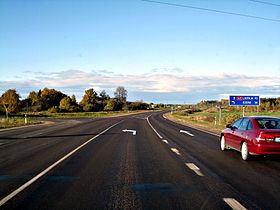|
Transport in Latvia
This article provides an overview of the transport infrastructure of Latvia. Road system   It is mandatory to keep headlights on while driving, even in daylight; most cars commercially sold in Latvia are equipped to make this automatic. Highways
Length of the road system
Railways  Latvian Railways is the main state-owned railway company in Latvia. Its daughter companies both carry out passengers services as well as carry a large quantity of freight cargo, and freight trains operate over the whole current passenger network, and a number of lines currently closed to passenger services. There is also a narrow gauge railway between Gulbene and Aluksne, operated by the Industrial Heritage Trust, using Russian and Polish built heritage rolling stock. Three narrow gauge trains a day operate on the 33 km route between the two towns.
Passenger railVivi is the only passenger-carrying operator in Latvia. Domestic passenger lines with current service are:
Rail links with adjacent countriesAirports Riga International Airport is the only major airport in Latvia, carrying around 5 million passengers annually. It is the largest airport in the Baltic states and has direct flights to over 80 destinations in 30 countries. It is also the main hub of airBaltic. In the recent years airBaltic also operated from Liepāja International Airport as well as Ventspils International Airport but operations in both of these airports were ceased until 2017, when airBaltic relaunched flights from Riga to Liepaja. Currently there are plans for further development in several regional airports, including Jūrmala Airport, Liepāja, Ventspils as well as Daugavpils International Airport. AirfieldsAs of 2003, there were a total of 51 airfields in Latvia, with 27 of them having paved runways. Airports - with paved runways
total:
27
Airports - with unpaved runways
total:
24
Ports and harbors  Key ports are located in Riga (Freeport of Riga and Riga Passenger Terminal), Ventspils (Free port of Ventspils), and Liepāja (Port of Liepāja). Most transit traffic uses these and half the cargo is crude oil and oil products.[1] Waterways300 km (perennially navigable) Pipelinescrude oil 412 km; refined products 421 km; natural gas 1,097 km (2003) Merchant marine
ReferencesExternal links |
